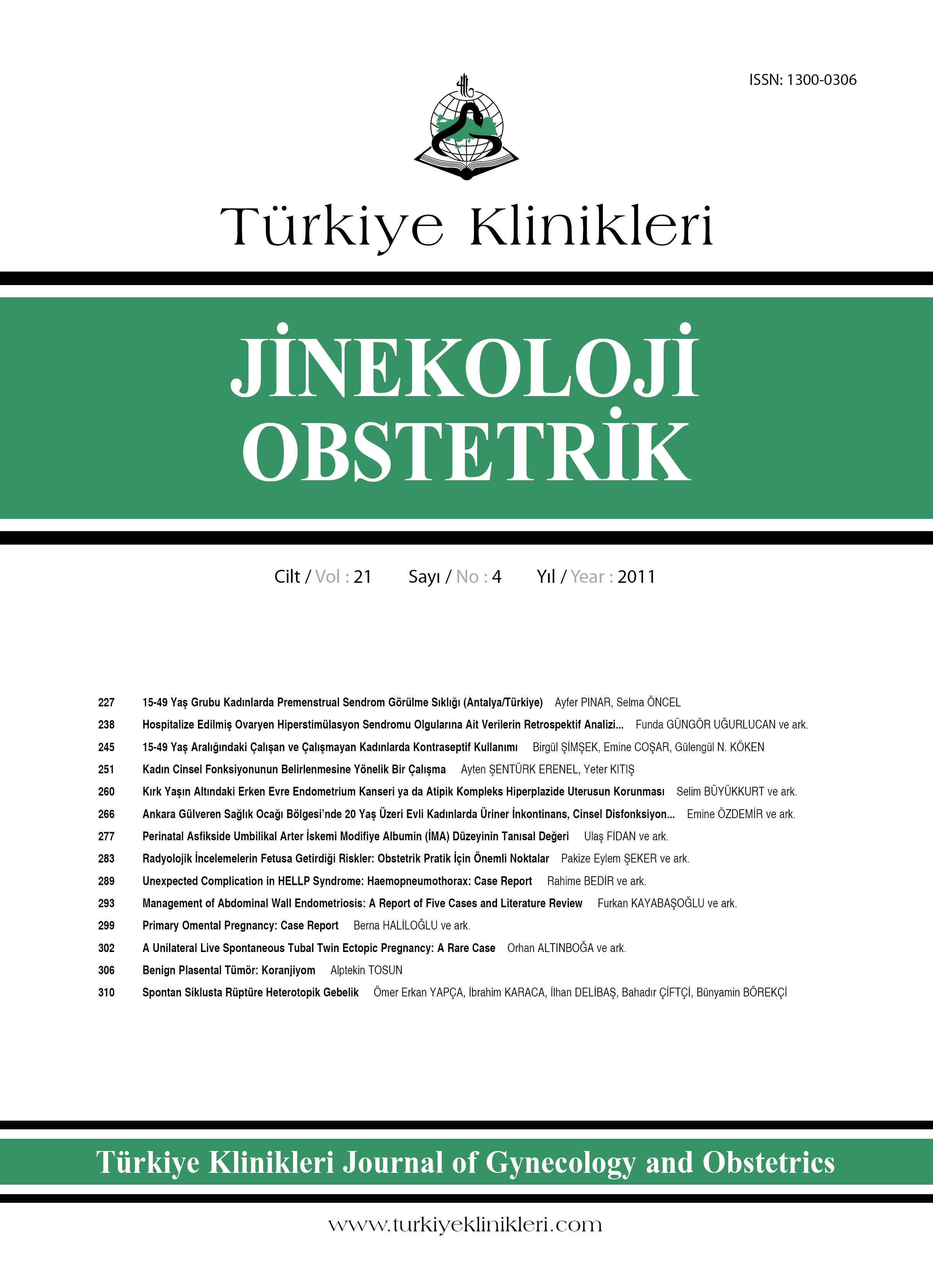Open Access
Peer Reviewed
ORIGINAL RESEARCH
3292 Viewed1355 Downloaded
Prevalance of Premenstrual Syndrome in Women in Between 15-49 Ages (Antalya/Turkey)
15-49 Yaş Grubu Kadınlarda Premenstrual Sendrom Görülme Sıklığı (Antalya/Türkiye)
Turkiye Klinikleri J Gynecol Obst. 2011;21(4):227-37
Article Language: TR
Copyright Ⓒ 2020 by Türkiye Klinikleri. This is an open access article under the CC BY-NC-ND license (http://creativecommons.org/licenses/by-nc-nd/4.0/)
ÖZET
Amaç: Bu araştırma, 15-49 yaş grubundaki kadınlarda premenstrual sendrom (PMS) görülme sıklığını belirlemek amacıyla yapılmıştır. Gereç ve Yöntemler: Araştırma Antalya il merkezindeki iki sağlık ocağı bölgesinde yapıldı. Örnekleme 15-49 yaş grubundaki toplam 600 kadın alındı. Araştırma Ekim 2005-Mart 2006 tarihleri arasında yapıldı. Veriler yüz yüze görüşme yöntemi ile sosyo-demografik özelliklerin alındığı soru formu ve Premenstrual Değerlendirme Formu (PDF) kullanılarak toplandı. Verilerin değerlendirilmesinde student t testleri, tek yönlü varyans analizi, Sheffe testi kullanıldı. Bulgular: Araştırmaya katılan kadınların %53.5'inin hafif ve %11.8'inin şiddetli derecede PMS yaşadıkları saptanmıştır. Kadınların premenstrual dönemde en fazla sorun yaşadıkları alt ölçekler sırasıyla; genel fiziksel rahatsızlık, yorgunluk, atipik depresif özellikler, düşmanlık/kızgınlık ve bunaltı alt ölçekleridir. Kadınların kendini iyi hissetmede artış, otonomik fiziksel değişimler ve histerik özellikler alt ölçeklerine ait şikâyetleri ise minimal düzeyde yaşadıkları saptanmıştır. Gecekondu bölgesinde yaşayan, sigara içen, çalışmayan, ortaokul mezunu olanlarda ve öğrencilerde PDF puan ortalamasının daha yüksek olduğu belirlenmiştir. Bunun yanında, medeni durum, beden kitle indeksi, en uzun süre yaşanılan yer, gebelik ve çocuk sayısı, sürekli ilaç kullanma, eş eğitimi ve mesleği, aile şekli ve gelir düzeyinin PDF puan ortalaması üzerinde etkisinin olmadığı saptanmıştır. Sonuç: Elde edilen sonuçlar doğrultusunda, 15-49 yaş grubu kadınlarda PMS'nin önemli bir sorun olduğu ve sağlık personellerinin bu konuda eğitim ve danışmanlık rollerini yerine getirmeleri önerilmektedir.
Amaç: Bu araştırma, 15-49 yaş grubundaki kadınlarda premenstrual sendrom (PMS) görülme sıklığını belirlemek amacıyla yapılmıştır. Gereç ve Yöntemler: Araştırma Antalya il merkezindeki iki sağlık ocağı bölgesinde yapıldı. Örnekleme 15-49 yaş grubundaki toplam 600 kadın alındı. Araştırma Ekim 2005-Mart 2006 tarihleri arasında yapıldı. Veriler yüz yüze görüşme yöntemi ile sosyo-demografik özelliklerin alındığı soru formu ve Premenstrual Değerlendirme Formu (PDF) kullanılarak toplandı. Verilerin değerlendirilmesinde student t testleri, tek yönlü varyans analizi, Sheffe testi kullanıldı. Bulgular: Araştırmaya katılan kadınların %53.5'inin hafif ve %11.8'inin şiddetli derecede PMS yaşadıkları saptanmıştır. Kadınların premenstrual dönemde en fazla sorun yaşadıkları alt ölçekler sırasıyla; genel fiziksel rahatsızlık, yorgunluk, atipik depresif özellikler, düşmanlık/kızgınlık ve bunaltı alt ölçekleridir. Kadınların kendini iyi hissetmede artış, otonomik fiziksel değişimler ve histerik özellikler alt ölçeklerine ait şikâyetleri ise minimal düzeyde yaşadıkları saptanmıştır. Gecekondu bölgesinde yaşayan, sigara içen, çalışmayan, ortaokul mezunu olanlarda ve öğrencilerde PDF puan ortalamasının daha yüksek olduğu belirlenmiştir. Bunun yanında, medeni durum, beden kitle indeksi, en uzun süre yaşanılan yer, gebelik ve çocuk sayısı, sürekli ilaç kullanma, eş eğitimi ve mesleği, aile şekli ve gelir düzeyinin PDF puan ortalaması üzerinde etkisinin olmadığı saptanmıştır. Sonuç: Elde edilen sonuçlar doğrultusunda, 15-49 yaş grubu kadınlarda PMS'nin önemli bir sorun olduğu ve sağlık personellerinin bu konuda eğitim ve danışmanlık rollerini yerine getirmeleri önerilmektedir.
ABSTRACT
Objective: This study was conducted as descriptive study in order to determine the frequency of premenstrual syndrome (PMS) in women between 15-49 ages. Material and Methods: This study was conducted in two primary health care units in the city centre of Antalya. The sample contained 600 women who were between 15-49 ages. It was conducted between October 2005 and March 2006. Data were obtained with face to face interview by using the sociodemographic information questionnaire and the Premenstrual Assessment Form. The student t-test, one-way analysis of variance and Scheffe test were used in the analysis of the data. Results: It was determined that 53.5% and 11.8% of participant women experienced mild-intermediate and serious PMS, respectively. The most problematic subscales experienced by the women were seen general physical discomfort, fatigue, atypical depressive signs, hostility/anger and anxiety. It was found that women rarely experience subscales related to increase in good self-feelings, autonomic physical changes and histeroid features. Average PMS scores found to be high in shanty town residents, smokers, unemployees and graduates of secondary school as well as students. Also, it was determined that marital status, body mass index, most commonly resided location, pregnancy and number of children, continuous medication, education and profession of husband, type of family and income status do not have statistically significant effect on average PMS scores. Conclusion: In accordance with these results, PMS was an important problem for the women between 15 and 49 age group, It was advised that the health personnel should perform education and take consulting roles.
Objective: This study was conducted as descriptive study in order to determine the frequency of premenstrual syndrome (PMS) in women between 15-49 ages. Material and Methods: This study was conducted in two primary health care units in the city centre of Antalya. The sample contained 600 women who were between 15-49 ages. It was conducted between October 2005 and March 2006. Data were obtained with face to face interview by using the sociodemographic information questionnaire and the Premenstrual Assessment Form. The student t-test, one-way analysis of variance and Scheffe test were used in the analysis of the data. Results: It was determined that 53.5% and 11.8% of participant women experienced mild-intermediate and serious PMS, respectively. The most problematic subscales experienced by the women were seen general physical discomfort, fatigue, atypical depressive signs, hostility/anger and anxiety. It was found that women rarely experience subscales related to increase in good self-feelings, autonomic physical changes and histeroid features. Average PMS scores found to be high in shanty town residents, smokers, unemployees and graduates of secondary school as well as students. Also, it was determined that marital status, body mass index, most commonly resided location, pregnancy and number of children, continuous medication, education and profession of husband, type of family and income status do not have statistically significant effect on average PMS scores. Conclusion: In accordance with these results, PMS was an important problem for the women between 15 and 49 age group, It was advised that the health personnel should perform education and take consulting roles.
MENU
POPULAR ARTICLES
MOST DOWNLOADED ARTICLES





This journal is licensed under a Creative Commons Attribution-NonCommercial-NoDerivatives 4.0 International License.











